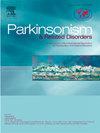A prediction model for the walking and balance milestone in Parkinson's disease
IF 3.1
3区 医学
Q2 CLINICAL NEUROLOGY
引用次数: 0
Abstract
Background
Walking and balance impairments, represented by freezing of gait and falls, are significant contributors to disability in advanced Parkinson's disease (PD) patients. However, the composite measure of the Walking and Balance Milestone (WBMS) has not been thoroughly investigated.
Methods
This study included 606 early-stage PD patients from the Parkinson's Progression Markers Initiative (PPMI) database, with a disease duration of less than 2 years and no WBMS at baseline. Patients were divided into a model development cohort (70 %) and a validation cohort (30 %) according to the enrollment site. Longitudinal follow-up data over a period of 12 years were analyzed.
Results
Among all 606 patients, the estimated probability of being WBMS-free at the 5th and 10th year was 88 % and 60 %, respectively. Five clinical variables (Age, Symbol Digit Modalities Test (SDMT), postural instability and gait difficulty (PIGD) score, Movement Disorder Society-Unified Parkinson's Disease Rating Scale Part I (MDS-UPDRS-I) score, and REM Sleep Behavior Disorder (RBD) were used to construct the Cox predictive model. The C-index of the model was 0.75 in the development cohort and 0.76 in the validation cohort. By optimizing the PIGD and MDS-UPDRS-I variables, an easy-to-use model was achieved with comparable predictive performance.
Conclusion
A predictive model based on five baseline clinical measures (Age, SDMT, PIGD score, MDS-UPDRS-I score, RBD) could effectively estimate the risk of the WBMS in early PD patients. This model is valuable for prognostic counseling and clinical intervention trials for gait and balance impairment.
帕金森病患者行走和平衡里程碑预测模型
背景以步态冻结和跌倒为代表的行走和平衡障碍是晚期帕金森病(PD)患者致残的重要原因。本研究纳入了帕金森病进展标志物倡议(PPMI)数据库中的606名早期帕金森病患者,这些患者的病程少于2年,基线时没有行走和平衡里程碑(WBMS)。根据入组地点,患者被分为模型开发队列(70%)和验证队列(30%)。结果在所有606名患者中,第5年和第10年无WBMS的估计概率分别为88%和60%。五个临床变量(年龄、符号数字模型测试(SDMT)、姿势不稳和步态困难(PIGD)评分、运动障碍协会-统一帕金森病评分量表第一部分(MDS-UPDRS-I)评分和快速眼动睡眠行为障碍(RBD))被用于构建Cox预测模型。该模型的 C 指数在开发队列中为 0.75,在验证队列中为 0.76。结论 基于五项基线临床指标(年龄、SDMT、PIGD 评分、MDS-UPDRS-I 评分、RBD)的预测模型可有效估计早期 PD 患者的 WBMS 风险。该模型对步态和平衡障碍的预后咨询和临床干预试验很有价值。
本文章由计算机程序翻译,如有差异,请以英文原文为准。
求助全文
约1分钟内获得全文
求助全文
来源期刊

Parkinsonism & related disorders
医学-临床神经学
CiteScore
6.20
自引率
4.90%
发文量
292
审稿时长
39 days
期刊介绍:
Parkinsonism & Related Disorders publishes the results of basic and clinical research contributing to the understanding, diagnosis and treatment of all neurodegenerative syndromes in which Parkinsonism, Essential Tremor or related movement disorders may be a feature. Regular features will include: Review Articles, Point of View articles, Full-length Articles, Short Communications, Case Reports and Letter to the Editor.
 求助内容:
求助内容: 应助结果提醒方式:
应助结果提醒方式:


